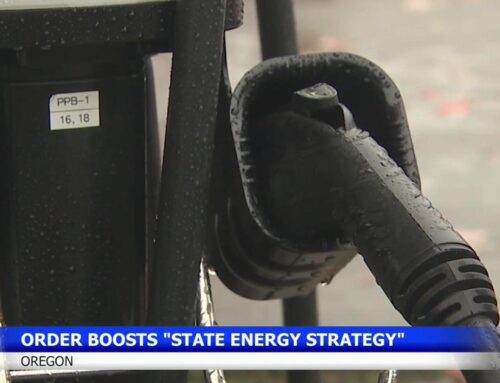Changes to NEPA May Limit Public Oversight of Environmental Projects
April 5, 2025
For decades, the National Environmental Policy Act (NEPA) has governed how projects done by federal agencies must assess their impacts, and how the public is informed about these projects.
But how does this legislation actually work in practice? And what changes are coming down the pike from the Trump administration?
What is NEPA, and why do we have this law?
NEPA was signed into law by Pres. Richard Nixon on January 1, 1970. It’s considered by many to be the “Magna Carta” of environmental law in the United States. Basically, it comes into play whenever a federal agency wants to take an action that may have environmental impacts.
Chris Winter is the director of the Getches Wilkinson Center for Natural Resources, Energy, and the Environment at CU Boulder’s School of Law. He says NEPA represents a shift in thinking at the time, from unregulated industry to more concern about the environment.
“It was during this period of environmental activism and awareness that the impacts of all of our economic activity and the development that was taking place was really taking a toll on the environment, on natural resources, and also on human health and welfare,” he said of NEPA’s passage.
Winter said there are two main pillars that govern how NEPA functions.
“Look before you leap, consider the environmental effects, and engage the public,” he said. “And so both of those things are really grounded in our fundamental democratic principles.”
Basically, that means when decision makers at federal agencies have a project they want to do, they must do a thorough analysis of what the project’s environmental impacts could be, provide that information to the public, and then seek feedback from the public on the project.
It’s also important to note that NEPA doesn’t prescribe a specific outcome, it simply mandates that a process be followed to ensure that environmental impacts are adequately assessed, and that the public can participate.

Hattison Rensberry
/
KDNK
When do we see the NEPA process play out in our lives?
Alli Henderson is the Southern Rockies Director for the Center for Biological Diversity. She said in the West, people are most often interacting with NEPA through public lands management.
“So, if we’re talking about a proposal for oil and gas on BLM (Bureau of Land Management) land or a timber sale on Forest Service land, NEPA is going to overlay that decision-making process, and that is what’s creating the transparency and opportunities for engagement from the public,” she said.
Resource management plans for BLM field offices are also subject to NEPA. Winter said there are even bigger conversations playing out that involve the law.
“What does it look like to manage the Colorado River after 2026 when our current operating guidelines expire? And what will the impacts be to farmers, to municipalities, to wildlife habitat, to recreation or changing, potentially, how we allocate water and manage water in the Colorado River?” Winter said. “So that whole entire process of how people and the public engage in that conversation and submit their views to the government on what the government should do, that whole process is governed by the National Environmental Policy Act.”
There are different levels of environmental analysis that can happen through NEPA. Depending on the scope and scale of the project, environmental analyses (EAs) or environmental impact statements (EISs) are required. EISs are more in depth, and there are typically multiple rounds of public comments for these projects.
Henderson says NEPA allows the public to really be stakeholders in public lands, especially because oftentimes, it’s private industry that’s looking to develop on federal lands.
“We’re talking about things that are managed in the interests of the public,” she said. “So surely the public should be having opportunities to engage with that decision-making that’s made from the federal agencies.”

How could the courts change the way NEPA works?
There have been some attempts to change how NEPA works in the fifty-five years it’s been the law. For example, how far out must agencies analyze when it comes to environmental impacts? That question is at the heart of a case currently before the Supreme Court.
In eastern Utah, the Seven County Infrastructure Coalition has a proposal to build 88 new miles of railroad track to transport waxy crude oil from the state’s oil-rich Uinta Basin. The new line would connect to existing Union Pacific tracks, and would eventually transport that oil to refineries in the Gulf of Mexico.
Colorado counties and the Center for Biological Diversity sued, saying that the Surface Transportation Board (STB) violated NEPA in its environmental impact statement, saying that it didn’t adequately consider some of the downstream impacts of transporting more crude oil on tracks that run alongside the Colorado River.
The plaintiffs want the Court to rule on how far downstream the impacts must be for an agency to consider them.
“Congress itself in 2023 used the language ‘reasonably foreseeable,’ so if the impacts are reasonably foreseeable, then they need to be considered by the agency,” said Winter.
The plaintiffs in the case want to change that measuring stick.
“They’re asking for a new test, which would ask whether the impacts are ‘remote in time and distance’ and whether they fall outside the jurisdiction of the agency who’s approving the project, and may fall within the jurisdiction of some other local, state or federal agency,” said Winter.
‘Remote in time and distance’ basically means that the environmental impact of a project could occur very far in the future, or geographically very far away from the project’s location.
Henderson says the Center for Biological Diversity takes issue with that stance. She says ignoring environmental impacts of the railroad that are further downstream, whether that’s emissions from the fossil fuels that will be produced or an oil spill in the Colorado River, doesn’t make them go away.
“If the agency is insulated from having to disclose to the public how many dominoes are going to end up falling, or what that’s going to end up doing environmentally, then we’re not going to be making a really informed decision, right?” she said.

Caroline Llanes
/
Rocky Mountain Community Radio
How is the Trump administration attempting to change NEPA?
It’s not just the courts where NEPA is being litigated. Over the years, a lot of criticism of NEPA has been that it’s unnecessarily burdensome, and slows down projects, especially energy development.
“The NEPA process has deviated from its original purpose, and evolved into a complicated, bureaucratic, Byzantine labyrinth where the only winner is a Washington bureaucrat and the loser is the hard-working American,” said Sen. Mike Lee (R-Utah) in a 2021 video discussing his legislation to reform NEPA.
The 2021 bill, Undoing NEPA’s Substantial Harm by Advancing Concepts that Kickstart the Liberation of the Economy (UNSHACKLE) Act, would have mandated that agencies complete the NEPA process in two years or less, and would have allowed agencies to delegate the NEPA process to state agencies in some cases, among other provisions.
But Alli Henderson says the critique of NEPA slowing down projects is disingenuous, especially when what’s at stake are public lands that are intended to be managed not just for economic value now, but for generations to come.
“That takes time, that takes staff, that takes expertise, right? It takes resource specialists,” she said. “And if we’re looking at agency budgets that continually get cut and we’re looking at staff that is getting annihilated from DOGE, things are going to take longer. That is not going to speed anything up. It is going to end up in more problems long-term.”
DOGE, or the Department of Government Efficiency, headed up by billionaire Elon Musk, is a stated effort by the Trump administration to cut federal waste and spending. Though not authorized by Congress, the task force has been behind the firings of thousands of federal employees, and cutting funds from federal agencies.
If officials want to speed up the NEPA process, Henderson said, they need to give agencies the staff and resources they need to actually do the work.
“The way that we address those is not to hide things from transparency and not to make it harder for informed decision-making,” Henderson said. “It should be to actually inject it with all the sorts of resources that are needed to do it right.”
And soon, things could get even more chaotic, thanks to President Donald Trump.
The governing body on all things NEPA has been the Council on Environmental Quality (CEQ). The council is under the executive branch, and has, for the past five decades, regulated how NEPA is implemented across federal agencies. But a February executive order says CEQ doesn’t have that authority, upending fifty years of legal precedent.
“CEQ has said, ‘we’re rescinding our nationwide regulations,’” Winter said. “And Trump is supposedly saying each individual agency should determine on its own how it wants to implement NEPA with some broad guidance, but no binding regulations that apply across the agencies.”
So now, federal agencies will have to come up with their own rules around the NEPA process. Legal scholars and advocates both say these
“I think we’re going to see agencies who are tasked with reviewing and approving projects, they’re going to be understaffed, going to be confused,” Winter said. “They’re not going to have concrete guidance. They won’t have the staff necessary to issue new regulations—their own regulations on NEPA.”
“I think we’re going to see a lot of delay and confusion and chaos in the federal government as it relates to implementation of NEPA moving forward.”

Caroline Llanes
/
Rocky Mountain Community Radio
What would this mean for the West and public lands?
Winter says it’s unclear how exactly this rule change will play out in practice, but it’s likely that agencies will use what’s called a “categorical exclusion.”
A categorical exclusion is a determination made very early in the NEPA process, that a proposed action will have little to no environmental impact, and is therefore not subject to a long environmental analysis or impact statement, or public comments. An example might be the Forest Service doing minor repair work to an office building, or trimming trees in the yard outside that building.
“Agencies might use categorical exclusions more frequently to try to limit types of actions or decisions they’re making that are subject to public notice and comment,” Winter said. “And so if that happens, then the public has to be much more vigilant and affirmatively reaching out to the agencies and asking what they’re doing versus sitting back and waiting for the agency to publicly publish a notice of a proposed decision.”
For rural western communities, that could impact the way that they interact with the federal agencies in their backyards.
In Pitkin County, where over 80% of the county is federal land, commissioners say these new rules are throwing the baby out with the bathwater.
In a March 25 meeting, Commissioner Greg Poschman said he and others at the county had been frustrated with NEPA at times, but to gut the law entirely would be “short-sighted.”
“In meetings over the last few years, (I) have advocated that we have… an ombudsman who can help us navigate NEPA more easily, something like that,” he said. “Just (to) help streamline it, but that doesn’t mean gut it and throw out the protections.”
Commissioner Franci Jacober agreed, saying that when it comes to public lands, slowing down may not be a bad thing for some projects.
“I would fight for NEPA, even if it meant slow processes,” she said.
The county submitted a letter commenting on the rule change, expressing their opposition.
“Weakening NEPA could open the door to unchecked extraction and development that compromises air and water quality, disrupts habitat, and undermines the scenic and recreational values that drive our regional economy,” it reads. “In Pitkin County and across the West, the strength of our communities is directly linked to the strength of our environmental protections.”
Alli Henderson agrees. She said chaos and uncertainty around NEPA, and a removal of transparency and public participation in the process, stands to benefit industry, especially fossil fuels companies that want to lease federal public lands for energy development.
“I think it is fair to say that the end goal here is to try to eviscerate the public process. and to eviscerate transparency and informed decision-making, and to make it easier for industries to feel like they can do whatever they want, whenever they want on public lands,” she said. “And I think that’s… an incredible disservice to the public, and for the lands, and the habitat that these species call home.”
“No place is ever permanently protected. It’s always in the process of being protected,” Winter said. “And right now, I feel like that’s true with our democracy as well.”
Winter and Henderson agree: that means people are going to have to work harder to be engaged on what’s happening in their federal public lands.
Henderson also said that NEPA is still the law, and groups like the Center for Biological Diversity will continue to make sure that federal law is enforced.
“It’s on the books. It is critically important for informed agency decision-making. And to the extent that the current administration is or will be doing things that are inconsistent with that law, then there are likely going to be efforts to hold them accountable.”
The interim rule removing CEQ’s authority to regulate NEPA goes into effect on April 11th.
Copyright 2025 Rocky Mountain Community Radio. This story was shared via Rocky Mountain Community Radio, a network of public media stations in Colorado, Wyoming, Utah, and New Mexico, including KSJD.
Search
RECENT PRESS RELEASES
Related Post




